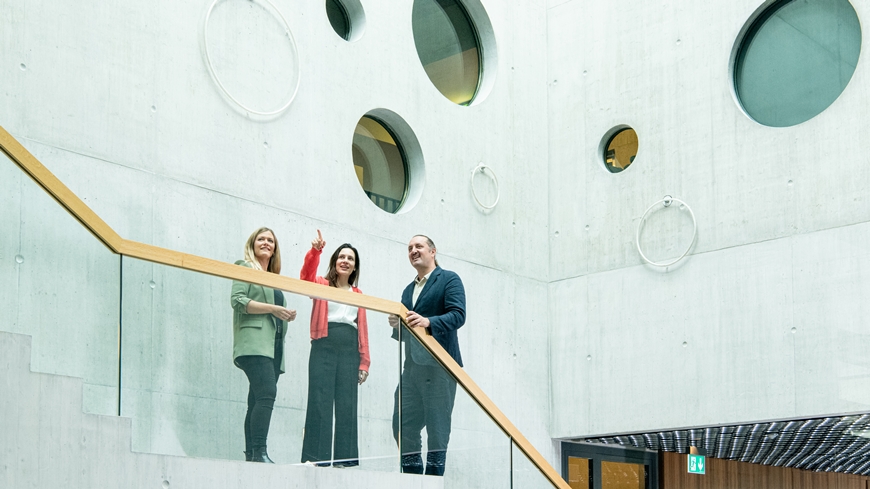Buildings as carbon sinks
Beyond Zero: Building for the climate
With its new research initiative Mining the Atmosphere, Empa is proposing nothing less than a paradigm shift: from a CO2-emitting to a CO2-binding society. The greenhouse gas is to be used as a valuable material – for example, as a carbon-based aggregate for concrete or as a thermal insulation material – and stored for the long term. In the NEST unit Beyond Zero, materials like these are being used and tested for the first time. Research, industry and planning are working hand in hand. In this interview, Nathalie Casas (Empa), Corinne Reimann (Implenia) and Christoph Kellenberger (OOS) shed light on the pioneering project from different perspectives.

Nathalie Casas, why do we need to take action? What is the purpose of negative emissions technologies (NET)?
Nathalie Casas: The level of CO2 emissions is increasing rapidly, making it impossible to achieve the 1.5-degree target. Thus, we need to take action. Negative emissions technologies (NET) can effectively remove excess CO2 from the atmosphere, allowing us to retrospectively clean it up. However, in addition to historical emissions, there are also future emissions that are difficult to avoid, such as those from aviation or agriculture. These emissions will require compensatory measures using NET.
The Mining the Atmosphere initiative was recently launched. Construction of the Beyond Zero unit in the NEST research and innovation building at Empa is currently being planned. What is needed next?
Nathalie Casas: There are many things to consider, but the most important is taking action. We need to move beyond just talking about climate change and start implementing solutions. This involves making new technologies, which are still on a laboratory scale, ready for the market, and adopting those, which are already available. We try to accelerate this for the construction sector with the planned NEST unit, Beyond Zero. The unit will test and install new materials that can reduce CO2 or are even CO2-negative. These innovative materials have shown promise in the laboratory, and we are now working to scale them up and prepare them for the market. This raises questions such as how the materials are produced and whether there are appropriate guidelines. It is crucial to collaborate with the right partners in this endeavor.
Why is it crucial to get planners on board when developing new building materials, Christoph Kellenberger?
Christoph Kellenberger: When designing a building, architects play a key role in determining the construction principles and choosing the building materials. It's important to involve planners early in the process of developing new building materials, so that practical knowledge can contribute to the innovation process. Additionally, architects can introduce new knowledge to the planning and construction industry and explain the benefits of using new CO2-neutral or CO2-negative building materials. Ultimately, the goal is to increase the carbon store in our building stock.
How do you evaluate the economic potential of NET in the construction industry, Corinne Reimann?
Corinne Reimann: NETs are a great opportunity for the construction industry as they enable the industry to make a significant contribution to sustainability. This is achieved through the use of CO2-neutral or CO2-negative materials such as concrete. Currently, the industry is perceived to be lagging behind in the area of sustainability, but it has significant potential, especially with the use of such materials.
What are the main challenges in this project?
Corinne Reimann: If the new concrete performs reliably and has the same functionality as traditional concrete, its potential usage is significant. The main challenge I foresee is its cost-effectiveness, specifically the price of the new concrete. This is a significant hurdle that should not be underestimated, as there seems to be a reluctance to bear additional costs. This is already evident on a small scale, for example with water-saving taps: If the investment pays off, everyone is on board; but if it becomes more expensive, people are less willing, unfortunately. I believe that we can only initiate this transformation with the help of subsidies because ultimately, the construction industry needs to act economically.
Christoph Kellenberger: Exactly. However, as I mentioned earlier, I see another crucial point in the transfer of knowledge – in addition to market-driven building materials, products, and construction principles, of course. It must be made transparent and comprehensible how these can be used and what effect can be achieved with them. Widespread use can be achieved most easily if the new materials are "significantly better" than what is currently on the market, motivating new suppliers to adopt these products. Regarding knowledge transfer, it is important to raise awareness in the planning and construction industries, which account for around 40% of current emissions from construction and operation, to the fact that they have a significant influence in reducing CO2 emissions. Additionally, simple and practical new construction solutions are needed for the use of materials that can store carbon in the building stock, and this knowledge must be put into practice.
So-called rebound effects lead to a change in behavioral patterns that can partially offset the savings that had originally been achieved. This is often observed with measures to increase energy efficiency. How do you evaluate the risk of a rebound effect with this CO2-reducing solution? Could NET indirectly lead to an increase in CO2 emissions because more buildings are then built "with a clear conscience"?
Nathalie Casas: We must not allow this to happen. Because even with the best technology, it will always be more expensive to clean up emissions than to avoid them in the first place. Removing CO2 from the atmosphere is costly and requires a lot of effort. It's essential to establish global transparency about these costs to prevent false assumptions that could lead to more emissions. However, we still have a long way to go to achieve this global cost transparency. It's crucial for politicians to take action, but it's also extremely challenging as this is a global issue that requires local action. The first step is to inform the public accordingly because NETs are certainly not a free pass to emit more CO2.
What contributions does society need to make to bring about this transformation?
Nathalie Casas: We need everyone. I believe that economically and technologically leading countries like Switzerland must lead by example. It can seem overwhelming when you see the mountain of tasks we are facing, but it's important to remember that every small contribution makes a difference.
And what about the economy and politics?
Christoph Kellenberger: Politicians need to establish the necessary framework for change. One of the quickest and most straightforward methods could involve implementing a system that puts a fair price on CO2 emissions. Moreover, building materials and construction should be designated as certified carbon sinks. This could facilitate a rapid transformation of the construction industry. With both new and existing knowledge, it is already feasible to create, construct, and operate a CO2-neutral building over its entire lifespan. Unfortunately, it's evident that other approaches only work to a limited extent. If the existing framework remains unchanged, new products and construction methods will have to compete on the market. While this is achievable, it presents a considerably greater challenge.
Corinne Reimann: I completely agree. Eventually, the construction industry needs to operate economically. To achieve this, appropriate framework conditions should be established or subsidies should be used to promote the use of these materials if we aim at building CO2-neutral or even CO2-negative buildings on a large scale. Once this is regulated, I believe it won't be long before these innovative materials become widespread in the economy. This is because, as it stands today, this new concrete can be handled almost the same way as conventional concrete, meaning that the industry doesn't need to make significant changes to its infrastructure and supply chains.
NEST-Unit "Beyond Zero"
The NEST unit Beyond Zero promotes promising CO2-reduced and CO2-negative innovations in the building sector and shows whether and how buildings can act as carbon sinks. The unit uses innovative building materials developed at Empa, such as concrete or insulation material, which can bind carbon. The project also analyzes the global feasibility of such technologies and shows how the transformation of the construction industry could be achieved. Beyond Zero is currently in the planning stage. More information on nest.empa.ch/beyondzero
Annina Schneider
Communications
Phone +41 58 765 4107
redaktion@empa.ch
Open Lab Day
On September 14, 2024, Empa Dübendorf will open the doors of its laboratories to the public. At over 70 stations, visitors will be able to experience current Empa research live on topics such as climate change, the energy transition, human and environmental health and much more. The stories in this issue give a small taste of the variety of materials and technologies that are discovered, researched, and developed in Empa's laboratories. Hungry for more? Visit us on September 14!
Read the latest EmpaQuarterly online or download the PDF version.
-
Share







